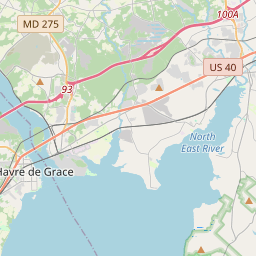Toll House & Tidewater Canal
Historical marker location:
Havre de Grace, Maryland
( Marker is at the intersection of Rock Run Road and Stafford Road, on the right when traveling east on Rock Run Road.)







© OpenStreetMap contributors
Loading...
Searching for other points of interest within 3 miles of this location.Maryland played a pivotal role in the American Revolution: Maryland was the site of several important battles during the American Revolution, including the Battle of Camden, the Battle of Cowpens, and the Battle of Yorktown. Additionally, Maryland's own soldiers played a crucial role in the war effort, including the famous "Maryland 400" who held off a British attack at the Battle of Long Island in 1776.
About Harford County
Harford County Timeline
Harford County, Maryland, has a rich and diverse history that dates back thousands of years. Native American tribes, including the Susquehannock and the Lenape, were the first inhabitants of the area. They relied on the region's lush forests, fertile lands, and abundant waterways for sustenance and trade.
In the 17th century, European settlers began to arrive in Harford County, lured by the promise of new opportunities. English colonists established towns along the Susquehanna River, such as Joppa and Havre de Grace, which served as important trading posts and transportation hubs. The area's fertile soil and favorable climate made it ideal for agriculture, leading to the rise of tobacco and later, wheat plantations.
During the American Revolutionary War, Harford County played a significant role in the fight for independence. Local militias formed to defend against British attacks, and the county became a vital center of support for the Continental Army. Harford even hosted the Second Continental Congress for a brief period in 1776, solidifying its place in early American history.
In the 19th and 20th centuries, Harford County experienced significant industrial and economic growth. The emergence of the railroad system and the establishment of manufacturing industries, such as textiles and canning, propelled the county into the modern era. Today, Harford County remains a vibrant and dynamic area, boasting a mix of suburban and rural communities, as well as a thriving economy supported by a diverse range of industries.
In the 17th century, European settlers began to arrive in Harford County, lured by the promise of new opportunities. English colonists established towns along the Susquehanna River, such as Joppa and Havre de Grace, which served as important trading posts and transportation hubs. The area's fertile soil and favorable climate made it ideal for agriculture, leading to the rise of tobacco and later, wheat plantations.
During the American Revolutionary War, Harford County played a significant role in the fight for independence. Local militias formed to defend against British attacks, and the county became a vital center of support for the Continental Army. Harford even hosted the Second Continental Congress for a brief period in 1776, solidifying its place in early American history.
In the 19th and 20th centuries, Harford County experienced significant industrial and economic growth. The emergence of the railroad system and the establishment of manufacturing industries, such as textiles and canning, propelled the county into the modern era. Today, Harford County remains a vibrant and dynamic area, boasting a mix of suburban and rural communities, as well as a thriving economy supported by a diverse range of industries.
Harford County Timeline
This timeline provides a concise overview of the key events in the history of Harford County, Maryland.
- 1608: Captain John Smith explores the Chesapeake Bay area, including what is now Harford County.
- 1692: Harford County is established as one of the original counties of the Province of Maryland.
- 1775-1783: Harford County actively participates in the American Revolutionary War.
- 1813: Havre de Grace, located in Harford County, is attacked by the British during the War of 1812.
- 1827: The Maryland and Pennsylvania Railroad is completed, connecting Harford County to neighboring states.
- 1851: The Female Institute, now known as Harford Community College, is established in Bel Air.
- 1861-1865: Harford County experiences significant Civil War activity, particularly during Confederate General Jubal Early's raid on Bel Air in 1864.
- 1879: The Maryland General Assembly designates Bel Air as the county seat.
- 1938: Aberdeen Proving Ground, a major US Army installation, is established in Harford County.
- 1964: The John F. Kennedy Memorial Highway, now Interstate 95, is completed, providing a crucial transportation link for the county.
- 1977: Harford Mall, the first large-scale shopping center in the county, opens in Bel Air.
- 2005: Harford County celebrates its 300th anniversary.